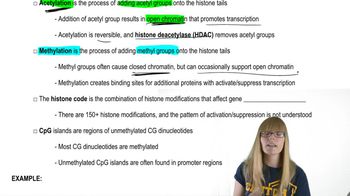Nucleosome Structure
A nucleosome is the fundamental unit of chromatin, consisting of a segment of DNA wrapped around a core of histone proteins. This structure helps package DNA into a compact form, allowing it to fit within the nucleus of a cell. Each nucleosome core particle is made up of eight histone proteins, forming a histone octamer, around which approximately 147 base pairs of DNA are tightly wound.
Recommended video:
Histones
Histones are highly alkaline proteins that play a crucial role in the organization and regulation of DNA within the cell nucleus. They help in the formation of nucleosomes by providing a scaffold for DNA wrapping. There are five main types of histones (H1, H2A, H2B, H3, and H4), with the core histones (H2A, H2B, H3, and H4) forming the nucleosome core, while H1 acts as a linker histone.
Recommended video:
Histone Protein Modifications
 Sanders 3rd Edition
Sanders 3rd Edition Ch. 10 - Eukaryotic Chromosome Abnormalities and Molecular Organization
Ch. 10 - Eukaryotic Chromosome Abnormalities and Molecular Organization Problem 1
Problem 1 Verified step by step guidance
Verified step by step guidance


